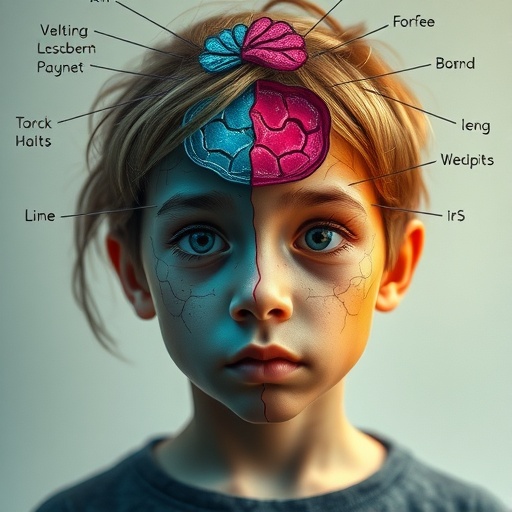In a groundbreaking new study published in BMC Psychiatry, researchers are delving deeper into the intricate relationship between autistic traits and psychotic disorders, illuminating critical clinical implications that have largely remained unexplored. While autism and psychosis have traditionally been treated as distinct neuropsychiatric conditions, recent evidence suggests a significant overlap in their symptomatic and behavioral features. This emerging insight challenges conventional diagnostic boundaries and calls for a revolutionary approach to understanding and managing these complex disorders.
The study, led by Ahi Üstün and colleagues, included 125 patients who had experienced at least one psychotic episode and had been treated primarily with antipsychotic medication. By combining structured clinical interviews with sophisticated self-report measures, the investigators aimed to unravel how autistic traits intersect with various clinical presentations and functional outcomes within the psychosis spectrum. Their research employed advanced path analysis techniques, enabling them to decode the multifaceted relationships between these intertwined symptom domains with precision.
One of the most compelling findings from this comprehensive analysis was the consistent negative association between the presence of autistic features and key indicators of patient well-being. Those with more pronounced autistic traits tended to exhibit poorer functioning, significantly diminished quality of life, and a decreased sense of benefit from their treatment regime. This suggests that the subtle nuances of autism might hinder therapeutic efficacy or impede recovery trajectories in individuals grappling with psychosis.
Delving further, the study revealed a robust positive correlation between autistic features and multiple dimensions of psychiatric symptom severity. Patients displaying autistic traits often contended with intensified depression, anxiety, and more severe positive symptoms such as hallucinations and delusions, alongside pronounced negative symptoms including social withdrawal and cognitive deficits. This symptom amplification underscores the complexity and layered nature of psychosis when intertwined with autistic characteristics.
Particularly striking was the revelation that depression severity played a mediating role in the relationship between autistic traits and suicidal ideation. The data indicated that heightened depressive symptoms in patients exhibiting autistic features significantly contributed to the emergence of suicidal thoughts and behaviors. This finding spotlights the urgent need for clinicians to carefully evaluate and address mood disorders within this subgroup to mitigate life-threatening risks.
The investigation also surfaced some unexpected socio-environmental associations. The data showed that patients who were non-smokers and those who had experienced bullying during their formative years reported a higher prevalence of autistic features. These links evoke considerations about how social adversity and personal habits might intertwine with neurodevelopmental and psychiatric trajectories, potentially influencing the manifestation and severity of autistic traits in psychosis.
From a clinical perspective, the study’s results underscore a critical knowledge gap in current psychiatric practice. Despite the evident overlap between autism and psychosis, healthcare providers often lack the diagnostic tools and treatment protocols needed to address this intersection effectively. Tailored interventions that recognize and integrate the unique challenges posed by comorbid autistic features may be essential to improving patient outcomes in this population.
This research is particularly noteworthy for its methodological rigor and the use of path analysis to map complex symptom interactions. Unlike traditional correlative studies, path analysis allows researchers to propose directional links among variables, offering a nuanced understanding of potential causal pathways—although the cross-sectional design of this study limits definitive conclusions about causality.
However, the authors caution that their findings represent a snapshot in time, emphasizing the necessity for longitudinal research to unpack the dynamic interplay between autism traits and psychosis over the course of illness progression. Prospective studies could illuminate how these overlapping features evolve and potentially inform earlier detection strategies and personalized therapeutic approaches.
The intersection of autistic features with suicidality, functional impairment, and symptom severity offers fertile ground for rethinking psychiatric classification systems. This work invites a paradigm shift wherein neurodevelopmental and psychotic disorders are not viewed in isolation but appreciated for their overlapping continua and shared neurobiological underpinnings.
Future investigations building on this study may spearhead the development of integrated diagnostic frameworks and innovative multimodal interventions. Such advances could enhance clinicians’ ability to identify at-risk individuals, tailor pharmacological and psychosocial treatments, and ultimately improve quality of life for those affected by the complex convergence of autistic features and psychosis.
In a broader context, linking autistic traits with psychotic symptoms challenges the rigid diagnostic silos that have historically compartmentalized mental health disorders. Bridging these divides could pave the way for a more holistic approach that acknowledges patients’ diverse needs and circumvents the limitations of current categorical models.
This study also raises crucial questions about neurodevelopmental vulnerability and resilience. Understanding why some individuals with autistic features develop psychosis while others do not may unlock new preventive and therapeutic targets, propelling the field toward precision psychiatry founded on robust biological and phenotypic characterizations.
In conclusion, the pioneering exploration by Ahi Üstün et al. provides compelling evidence that autistic traits are not merely ancillary symptoms in psychosis but integral factors influencing clinical course, symptomatology, and treatment response. Their work serves as a clarion call for researchers and clinicians alike to intensify efforts aimed at unraveling the clinical complexities of the autism-psychosis nexus and to translate these insights into tangible improvements in mental health care.
Subject of Research:
Clinical implications of autistic traits in individuals with psychosis spectrum disorders.
Article Title:
Clinical implications of autistic features in the psychosis spectrum: a cross-sectional study using path analysis
Article References:
Ahi Üstün, E.S., Yazıcı, S., İlhan, R.S. et al. Clinical implications of autistic features in the psychosis spectrum: a cross-sectional study using path analysis. BMC Psychiatry 25, 902 (2025). https://doi.org/10.1186/s12888-025-07377-z
Image Credits: AI Generated




